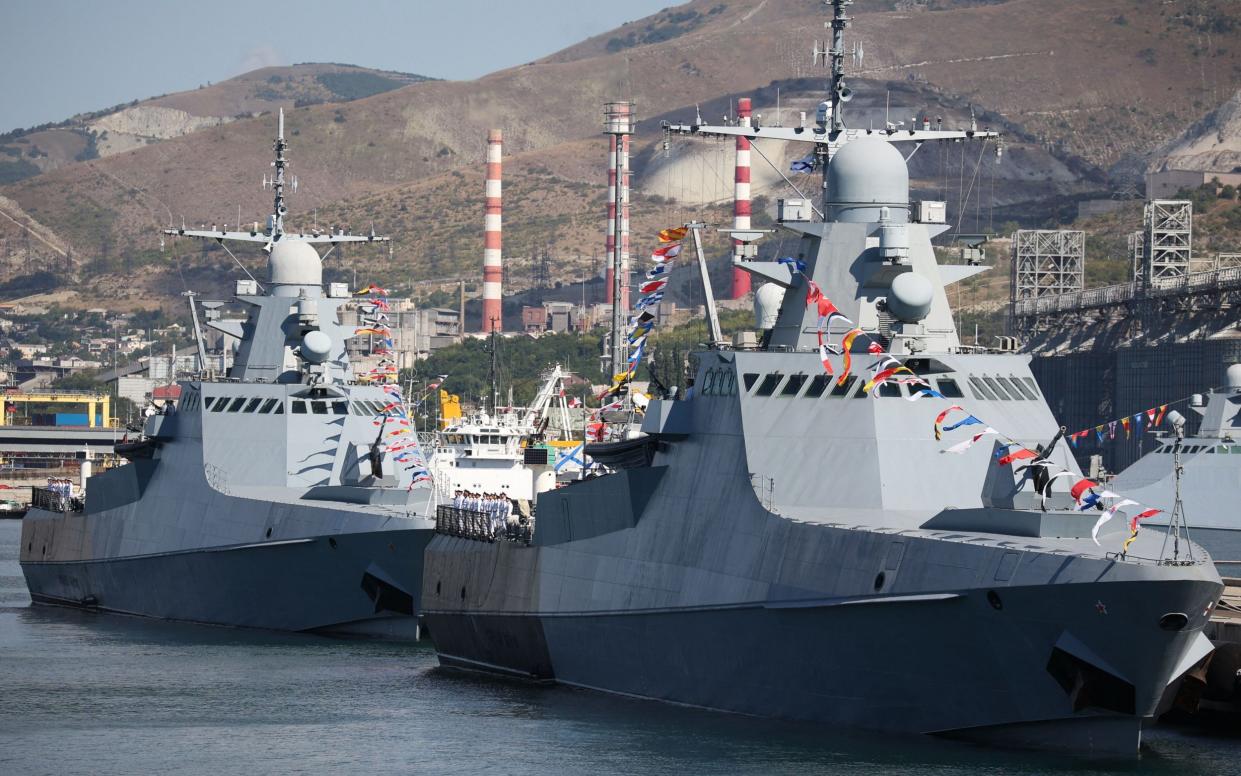Russia has been politically embarrassed, operationally dominated and tactically outfought

- Oops!Something went wrong.Please try again later.
War is rarely clear-cut. Clearly defined ‘front lines’ that can be breached by heroic attacks don’t really exist outside Hollywood, and the search for clear winners and losers can be so blurred by the super slow-mo scrutiny (with VAR levels of inaccuracy) of modern communications that people find them where they don’t exist. The fog of war is very real, and gets worse as technology advances.
Nevertheless, what is happening in Crimea at the moment is huge: radars taken out by special forces in August; UK-supplied Storm Shadow strikes killing a Kilo-class submarine and a Ropucha-class landing ship; a well-timed follow-up strike destroying a headquarters full of retreating senior staff in September; a special forces jet-ski raid showing Cockleshell Hero levels of bravery and audacity in October.
Sevastopol’s viability as a base isn’t dead yet – as of yesterday there are five warships alongside there – but to quote my American military friends, it’s “taking one hell of a beat-down”. And it might bounce back. History has plenty of examples of military locations defended well beyond practical worth out of pride or misplaced emotion. One thing is for sure: life in the naval base there can’t be much fun at the moment.
The Armed Forces Minister James Heappey recently described the Black Sea Fleet as ‘functionally defeated’. In warship terms, it is possible to achieve what’s called a mission kill without sinking the enemy ship. Taking out a major weapon system, destroying the operations room or crippling the propulsion are examples of this. It can also be done by eroding their will to fight to the point of combat ineffectiveness.
If that’s what he meant by ‘functionally defeated’, then for Sevastopol, he is right. But that is just Sevastopol. Jet-skis and flags are brilliant, but they don’t retake Crimea. And what about the rest of the Black Sea Fleet now displaced but not out of the war? Their ability to disrupt and deter shipping, in particular grain exports from Ukraine, has been hampered but not stopped.
Russia’s ability to operate warships in the North-western Black Sea to harass and interdict ships there is now almost zero, but that has more to do with Ukraine’s superior weapons and surveillance coverage than events in Sevastopol. And it’s not totally zero – the Kremlin has already shown ample willingness to take significant losses if they feel they have to.
Right now in Novorossiysk there are seven Kalibr cruise missile shooters, three of which are Kilos that can also lay mines. The problem with these assets is it doesn’t really matter where in the Black Sea they are based. Kalibr has the legs to strike from anywhere and a submarine laying mines will not be deterred by Ukrainian missiles. They also have some maritime air assets, although these are sparse and ageing.
Mines are a critical part of this strategy. They provide a cheap and effective way to control sea lanes, driving risk and associated insurance premiums up in their wake. They are deniable and, worryingly, often unaccounted for, free-floating into harm’s way. The Royal Navy’s decision to sell two minehunters to Romania last week looks sound. Discussions about allowing Nato mine countermeasures groups into the Black Sea are probably premature, but at some point the mine clearance effort at sea will demand it.
Putin’s argument for seizing Crimea was built on the premise that it was of vital strategic interest. But if its fleet is no longer safe there, then at what point does the whole peninsula become just another portion of Ukrainian territory seized by Russia illegally, and which ought to be returned? Current talks of building a naval base on the Black Sea coast of the breakaway Georgian region of Abkhazia can’t help this sense of political embarrassment in the Kremlin.
Operationally, the Ukrainians have the upper hand in the Black Sea. Russia is being forced to react and is doing so in a disconnected way. Command and control appears fractured, missions are haphazard and poorly planned. The loss of Sevastopol can only make this worse.
Tactically the Ukrainians are showing great levels of ingenuity and flexibility with coordinated multi-domain attacks using a blend of traditional and novel weapon systems. Navies and procurement departments around the world will be pouring over the lessons from this at a fundamental level – or at least should be.
Has the tide turned in the naval battle to the extent that Ukraine can now achieve its strategic objectives and Russia cannot? The FCDO announced only yesterday that the threat to British shipping remains “at the highest level”. Sevastopol has been badly damaged, but has Ukraine got enough assets to hit Crimea at will, making it too dangerous for 800k Russians to live there? Not quite.
There is a danger that the lack of a ‘Hollywood-style breakthrough’ in the land war means that people are now searching too hard for it elsewhere. Recent events in Crimea and in particular Sevastopol are seismic; Russia has been politically embarrassed, operationally dominated and tactically outfought. Fighting morale in the Black Sea Fleet must be at an all-time low. But unless this converts into the restoration of something akin to freedom of navigation in the Black Sea, I don’t believe it can’t truly be called a strategic turning point – at least, not yet.
Tom Sharpe is a former Royal Navy officer and frigate captain

